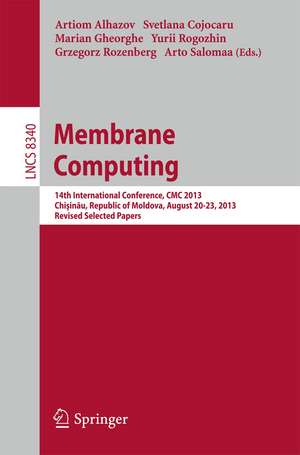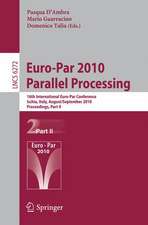Membrane Computing: 14th International Conference, CMC 2013, Chişinău, Republic of Moldova, August 20-23, 2013, Revised Selected Papers: Lecture Notes in Computer Science, cartea 8340
Editat de Artiom Alhazov, Svetlana Cojocaru, Marian Gheorghe, Yurii Rogozhin, Grzegorz Rozenberg, Arto Salomaaen Limba Engleză Paperback – 3 feb 2014
The 16 revised selected papers presented together with 6 invited lectures were carefully reviewed and selected from 26 papers presented at the conference. Membrane computing is an area of computer science aiming to abstract computing ideas and models from the structure and the functioning of living cells, as well as from the way the cells are organized in tissues or higher order structures. It deals with membrane systems, also called P systems, which are distributed and parallel algebraic models processing multi sets of objects in a localized manner (evolution rules and evolving objects are encapsulated into compartments delimited by membranes), with an essential role played by the communication among compartments and with the environment.
Din seria Lecture Notes in Computer Science
- 20%
 Preț: 1061.55 lei
Preț: 1061.55 lei - 20%
 Preț: 307.71 lei
Preț: 307.71 lei - 20%
 Preț: 438.69 lei
Preț: 438.69 lei - 20%
 Preț: 579.30 lei
Preț: 579.30 lei -
 Preț: 410.88 lei
Preț: 410.88 lei - 17%
 Preț: 427.22 lei
Preț: 427.22 lei - 20%
 Preț: 596.46 lei
Preț: 596.46 lei - 15%
 Preț: 448.04 lei
Preț: 448.04 lei - 20%
 Preț: 353.50 lei
Preț: 353.50 lei -
 Preț: 389.49 lei
Preț: 389.49 lei - 20%
 Preț: 309.90 lei
Preț: 309.90 lei - 20%
 Preț: 645.28 lei
Preț: 645.28 lei - 20%
 Preț: 763.23 lei
Preț: 763.23 lei - 15%
 Preț: 580.46 lei
Preț: 580.46 lei - 20%
 Preț: 310.28 lei
Preț: 310.28 lei - 20%
 Preț: 655.02 lei
Preț: 655.02 lei - 20%
 Preț: 1183.14 lei
Preț: 1183.14 lei - 20%
 Preț: 340.32 lei
Preț: 340.32 lei -
 Preț: 449.57 lei
Preț: 449.57 lei - 20%
 Preț: 591.51 lei
Preț: 591.51 lei - 18%
 Preț: 938.83 lei
Preț: 938.83 lei - 20%
 Preț: 337.00 lei
Preț: 337.00 lei - 20%
 Preț: 649.50 lei
Preț: 649.50 lei - 20%
 Preț: 607.40 lei
Preț: 607.40 lei - 20%
 Preț: 1414.79 lei
Preț: 1414.79 lei - 20%
 Preț: 1024.44 lei
Preț: 1024.44 lei - 20%
 Preț: 583.40 lei
Preț: 583.40 lei - 20%
 Preț: 453.32 lei
Preț: 453.32 lei - 20%
 Preț: 575.49 lei
Preț: 575.49 lei - 20%
 Preț: 1075.26 lei
Preț: 1075.26 lei - 20%
 Preț: 585.88 lei
Preț: 585.88 lei - 20%
 Preț: 825.93 lei
Preț: 825.93 lei - 17%
 Preț: 360.20 lei
Preț: 360.20 lei - 20%
 Preț: 763.23 lei
Preț: 763.23 lei - 20%
 Preț: 340.32 lei
Preț: 340.32 lei - 20%
 Preț: 504.58 lei
Preț: 504.58 lei - 20%
 Preț: 369.13 lei
Preț: 369.13 lei - 20%
 Preț: 580.93 lei
Preț: 580.93 lei - 20%
 Preț: 343.62 lei
Preț: 343.62 lei - 20%
 Preț: 350.21 lei
Preț: 350.21 lei - 20%
 Preț: 583.40 lei
Preț: 583.40 lei - 20%
 Preț: 583.40 lei
Preț: 583.40 lei - 15%
 Preț: 438.59 lei
Preț: 438.59 lei - 20%
 Preț: 341.95 lei
Preț: 341.95 lei - 20%
 Preț: 238.01 lei
Preț: 238.01 lei - 20%
 Preț: 538.30 lei
Preț: 538.30 lei
Preț: 334.38 lei
Preț vechi: 417.97 lei
-20% Nou
Puncte Express: 502
Preț estimativ în valută:
63.98€ • 66.81$ • 52.83£
63.98€ • 66.81$ • 52.83£
Carte tipărită la comandă
Livrare economică 16-30 aprilie
Preluare comenzi: 021 569.72.76
Specificații
ISBN-13: 9783642542381
ISBN-10: 3642542387
Pagini: 336
Ilustrații: X, 323 p. 23 illus.
Dimensiuni: 155 x 235 x 18 mm
Greutate: 0.47 kg
Ediția:2014
Editura: Springer Berlin, Heidelberg
Colecția Springer
Seriile Lecture Notes in Computer Science, Theoretical Computer Science and General Issues
Locul publicării:Berlin, Heidelberg, Germany
ISBN-10: 3642542387
Pagini: 336
Ilustrații: X, 323 p. 23 illus.
Dimensiuni: 155 x 235 x 18 mm
Greutate: 0.47 kg
Ediția:2014
Editura: Springer Berlin, Heidelberg
Colecția Springer
Seriile Lecture Notes in Computer Science, Theoretical Computer Science and General Issues
Locul publicării:Berlin, Heidelberg, Germany
Public țintă
ResearchCuprins
A Kernel P Systems Survey.- Roads to New Grand Challenges of Informatics.- Computational Complexity of P Systems with Active Membranes.- Some Open Problems about Catalytic, Numerical, and Spiking Neural P Systems.- Active Membranes, Proteins on Membranes, Tissue P Systems: Complexity-Related Issues and Challenges.- Using the Formal Framework for P Systems.- A P System for Annotation of Romanian Affixes.- Behavioural Equivalences in Real-Time P Systems.- Modelling of Surface Runoff Using 2D P Colonies.- Implementation of P Systems by Using Big Data Technologies.- On Counter Machines versus dP Automata.- Model Checking Kernel P Systems.- Flattening in (Tissue) P Systems.- Solving SAT by P Systems with Active Membranes in Linear Time in the Number of Variables.- On Communication Complexity of Some Hard Problems in ECPe Systems.- About One-Sided One-Symbol Insertion-Deletion P Systems.- Flattening and Simulation of Asynchronous Division less P Systems with Active Membranes.- Enzymatic Numerical P Systems Using Elementary Arithmetic Operations.- Communication Rules Controlled by Generated Membrane Boundaries.- Programming P Systems with Complex Objects.- In Search of a Structure of Fractals by Using Membranes as Hyper edges.- The Relevance of the Environment on the Efficiency of Tissue P Systems.
Textul de pe ultima copertă
This book constitutes the thoroughly refereed post-conference proceedings of the 14th International Conference on Membrane Computing, CMC 2013, held in Chişinău, Republic of Moldova, in August 2013.
The 16 revised selected papers presented together with 6 invited lectures were carefully reviewed and selected from 26 papers presented at the conference. Membrane computing is an area of computer science aiming to abstract computing ideas and models from the structure and the functioning of living cells, as well as from the way the cells are organized in tissues or higher order structures. It deals with membrane systems, also called P systems, which are distributed and parallel algebraic models processing multisets of objects in a localized manner (evolution rules and evolving objects are encapsulated into compartments delimited by membranes), with an essential role played by the communication among compartments and with the environment.
The 16 revised selected papers presented together with 6 invited lectures were carefully reviewed and selected from 26 papers presented at the conference. Membrane computing is an area of computer science aiming to abstract computing ideas and models from the structure and the functioning of living cells, as well as from the way the cells are organized in tissues or higher order structures. It deals with membrane systems, also called P systems, which are distributed and parallel algebraic models processing multisets of objects in a localized manner (evolution rules and evolving objects are encapsulated into compartments delimited by membranes), with an essential role played by the communication among compartments and with the environment.























